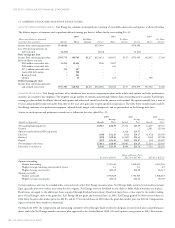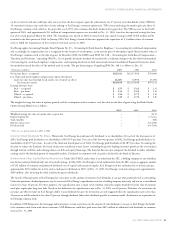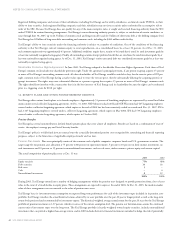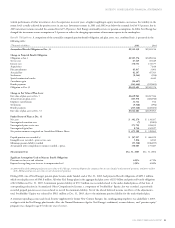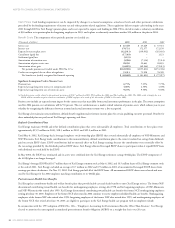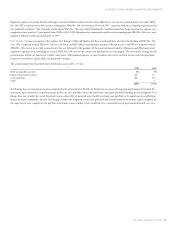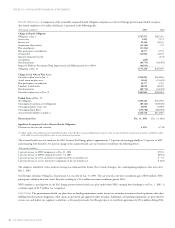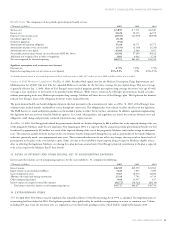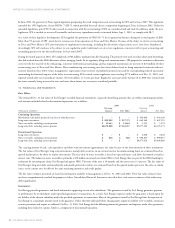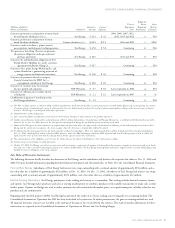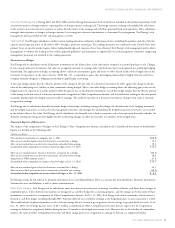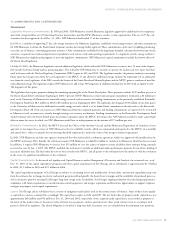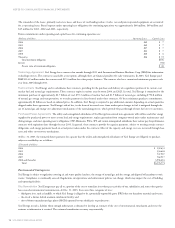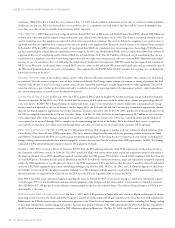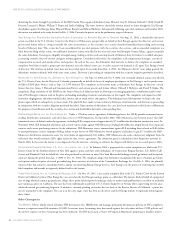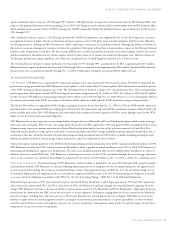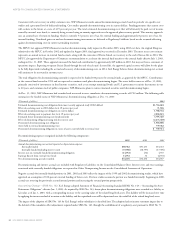Xcel Energy 2003 Annual Report Download - page 56
Download and view the complete annual report
Please find page 56 of the 2003 Xcel Energy annual report below. You can navigate through the pages in the report by either clicking on the pages listed below, or by using the keyword search tool below to find specific information within the annual report.72 XCEL ENERGY 2003 ANNUAL REPORT
NOTES TO CONSOLIDATED FINANCIAL STATEMENTS
Regulated Operations Xcel Energy’s regulated utility energy marketing operations use a combination of electricity and natural gas purchase for resale
futures and forward contracts, along with physical supply, to hedge market risks in the energy market. At Dec. 31, 2003, the notional amount of these
contracts was approximately 56 million MMBtu of natural gas and 62,400 megawatt-hours of electricity. The fair value of these contracts as of Dec. 31, 2003,
was approximately $(11.2) million.
Nonregulated Operations Xcel Energy’s nonregulated operations use a combination of energy futures and forward contracts, along with physical
supply, to hedge market risks in the energy market. At Dec. 31, 2003, the notional amount of these contracts was approximately 6.6 million MMBtu
of natural gas. The fair value of these contracts as of Dec. 31, 2003, was approximately $1.5 million. The value of hedges related to nonregulated
operations is included in discontinued operations.
Foreign Currency Xcel Energy and its subsidiaries have no foreign currency swaps to hedge or protect foreign currency denominated cash flows at
Dec. 31, 2003.
Letters of Credit
Xcel Energy and its subsidiaries use letters of credit, generally with terms of one year, to provide financial guarantees for certain operating obligations. At
Dec. 31, 2003, there was $95.5 million of letters of credit outstanding. The contract amounts of these letters of credit approximate their fair value and
are subject to fees determined in the marketplace.
16. DERIVATIVE VALUATION AND FINANCIAL IMPACTS
Use of Derivatives to Manage Risk
Business and Operational Risk Xcel Energy and its subsidiaries, including discontinued operations held for sale, are exposed to commodity price
risk in their generation, retail distribution and energy trading operations. In certain jurisdictions, purchased power expenses and natural gas costs are
recovered on a dollar-for-dollar basis. However, in other jurisdictions, Xcel Energy and its subsidiaries are exposed to market price risk for the purchase
and sale of electric energy and natural gas. In such jurisdictions, Xcel Energy recovers purchased power expenses and natural gas costs based on fixed
price limits or under established sharing mechanisms.
Commodity price risk is managed by entering into purchase and sales commitments for electric power and natural gas, long-term contracts for coal
supplies and fuel oil, and derivative financial instruments. Xcel Energy’s risk management policy allows it to manage the market price risk within each
rate-regulated operation to the extent such exposure exists. Management is limited under the policy to enter into only transactions that manage market
price risk where the rate regulation jurisdiction does not already provide for dollar-for-dollar recovery. One exception to this policy exists in which
Xcel Energy and its subsidiaries use various physical contracts and derivative instruments to reduce the volatility in the cost of natural gas and electricity
provided to retail customers even though the regulatory jurisdiction provides dollar-for-dollar recovery of actual costs. In these instances, the use of
derivative instruments and physical contracts is done consistently with the local jurisdictional cost recovery mechanism.
Xcel Energy and its subsidiaries have been exposed to market price risk for the sale of electric energy and the purchase of fuel resources, including coal,
natural gas and fuel oil used to generate the electric energy within its nonregulated operations, primarily through NRG and Xcel Energy International.
With the divestiture of NRG and the expected sale of Xcel Energy International, the exposure to market price risk has greatly decreased. Xcel Energy
managed this market price risk by entering into firm power sales agreements for approximately 55 percent to 75 percent of its electric capacity and energy
from each generation facility, using contracts with terms ranging from one to 25 years. In addition, Xcel Energy managed the market price risk covering
the fuel resource requirements to provide the electric energy by entering into purchase commitments and derivative instruments for coal, natural gas and
fuel oil as needed to meet fixed-priced electric energy requirements. Xcel Energy’s risk management policy allows the management of market price risks,
and provides guidelines for the level of price risk exposure that is acceptable within the company’s operations.
Interest Rate Risk Xcel Energy and its subsidiaries are subject to the risk of fluctuating interest rates in the normal course of business.
Xcel Energy’s policy allows interest rate risk to be managed through the use of fixed rate debt, floating rate debt and interest rate derivatives
such as swaps, caps, collars and put or call options.
Xcel Energy engages in hedges of cash flow exposure and hedges of fair value exposure. The fair value of interest rate swaps designated as cash flow
hedges are initially recorded in Other Comprehensive Income. Reclassification of unrealized gains or losses on cash flow hedges of variable rate debt
instruments from Other Comprehensive Income into earnings occurs as interest payments are accrued on the debt instrument and generally offsets the
change in the interest accrued on the underlying variable rate debt. Hedges of fair value exposure are entered into to hedge the fair value of a recognized
asset, liability or firm commitment. Changes in the derivative fair values that are designated as fair value hedges are recognized in earnings as offsets
to the changes in fair values of related hedged assets, liabilities or firm commitments. In order to test the effectiveness of such swaps, a hypothetical
swap is used to mirror all the critical terms of the underlying debt and regression analysis is utilized to assess the effectiveness of the actual swap at
inception and on an ongoing basis. The assessment is done periodically to ensure the swaps continue to be effective. The fair value of interest rate swaps
is determined through counterparty valuations, internal valuations and broker quotes. There have been no material changes in the techniques or models
used in the valuation of interest rate swaps during the periods presented.


